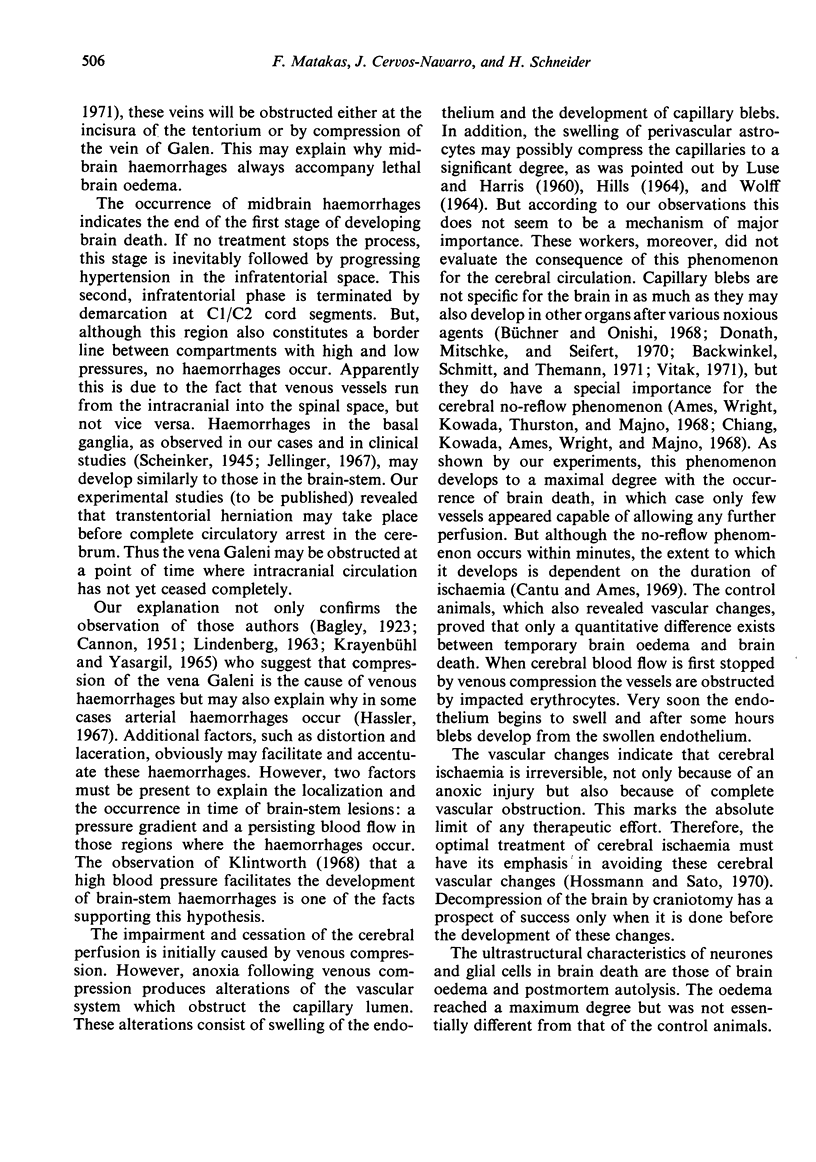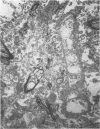Abstract
The morphological characteristics of brain death were examined in baboons and cats after artificial cerebral ischaemia. All animals showed autolytic changes in the brain, ischaemic neuronal changes, midbrain haemorrhages, focal necrosis of the brain-stem, demarcation at C 1/C 2 cord segment, and displacement of cerebellar tissue. Ultrastructural examination revealed extreme brain oedema, autolytic changes, and complete obstruction of capillaries by astrocytic and endothelial swelling and intravascular blebs. These data indicate that brain death develops in several stages. If the process starts in the supratentorial space it first leads to a breakdown of the cerebral circulation and to transtentorial herniation. As a result, midbrain haemorrhages develop and the infratentorial pressure begins to rise. The second stage is terminated by demarcation of the brain. The circulatory arrest is initially caused by venous compression but becomes irreversible when vascular obstruction develops.
Full text
PDF











Images in this article
Selected References
These references are in PubMed. This may not be the complete list of references from this article.
- Ames A., 3rd, Wright R. L., Kowada M., Thurston J. M., Majno G. Cerebral ischemia. II. The no-reflow phenomenon. Am J Pathol. 1968 Feb;52(2):437–453. [PMC free article] [PubMed] [Google Scholar]
- BERTRAND I., LHERMITTE F., ANTOINE B. [Massive necrosis of the central nervous system in a subject kept alive artificially]. Rev Neurol (Paris) 1959 Aug;101:101–115. [PubMed] [Google Scholar]
- Backwinkel K. P., Schmitt G., Themann H. Elektronenmikroskopische und cytochemische Untersuchungen an Capillaren des Herzmuskels nach experimenteller Hypertonie und Hypoxie. Virchows Arch B Cell Pathol. 1971;7(2):90–98. [PubMed] [Google Scholar]
- Bücheler E., Käufer C., Düx A. Zerebrale Angiographie zur Bestimmung des Hirntodes. Fortschr Geb Rontgenstr Nuklearmed. 1970 Sep;113(3):278–296. [PubMed] [Google Scholar]
- CANNON B. W. Acute vascular lesions of the brain stem; a complication of supratentorial space-occupying lesions. AMA Arch Neurol Psychiatry. 1951 Dec;66(6):687–696. doi: 10.1001/archneurpsyc.1951.02320120020002. [DOI] [PubMed] [Google Scholar]
- Cantu R. C., Ames A., 3rd Distribution of vascular lesions caused by cerebral ischemia. Relation to survival. Neurology. 1969 Feb;19(2):128–132. doi: 10.1212/wnl.19.2.128. [DOI] [PubMed] [Google Scholar]
- Chiang J., Kowada M., Ames A., 3rd, Wright R. L., Majno G. Cerebral ischemia. III. Vascular changes. Am J Pathol. 1968 Feb;52(2):455–476. [PMC free article] [PubMed] [Google Scholar]
- David E., Marx I., David H. Das ultrastrukturelle Bild der Nervenzelle in verschiedenen Regionen des Meerschweinchengehirns im Verlauf der postmortalen Autulyse. Exp Pathol (Jena) 1971;5(1):98–106. [PubMed] [Google Scholar]
- Donath K., Mitschke H., Seifert G. Ultrastrukturelle Veränderungen am Rattenpankreas beim hämorrhagischen Schock. Beitr Pathol. 1970;141(1):33–51. [PubMed] [Google Scholar]
- Hassler O. Arterial pattern of human brainstem. Normal appearance and deformation in expanding supratentorial conditions. Neurology. 1967 Apr;17(4):368–passim. doi: 10.1212/wnl.17.4.368. [DOI] [PubMed] [Google Scholar]
- Hassler O. Venous anatomy of human hindbrain. A stereomicroangiographic study of the venous angio-architecture and the venous areas of drainage. Arch Neurol. 1967 Apr;16(4):404–409. doi: 10.1001/archneur.1967.00470220068007. [DOI] [PubMed] [Google Scholar]
- Hekmatpanah J. Cerebral circulation and perfusion in experimental increased intracranial pressure. J Neurosurg. 1970 Jan;32(1):21–29. doi: 10.3171/jns.1970.32.1.0021. [DOI] [PubMed] [Google Scholar]
- Hills C. P. Ultrastructural changes in the capillary bed of the rat cerebral cortex in anoxic-ischemic brain lesions. Am J Pathol. 1964 Apr;44(4):531–551. [PMC free article] [PubMed] [Google Scholar]
- Holdorff B., Cervos-Navarro J. Die Pathologie der inneren ponto-mesencephalen Venen. Radiologe. 1971 Dec;11(12):465–471. [PubMed] [Google Scholar]
- Hossmann K. A., Sato K. The effect of ischemia on sensorimotor cortex of cat. Electrophysiological, biochemical and electronmicroscopial observations. Z Neurol. 1970;198(1):33–45. doi: 10.1007/BF00316134. [DOI] [PubMed] [Google Scholar]
- Huang Y. P., Wolf B. S. The veins of the posterior fossa--superior or galenic draining group. Am J Roentgenol Radium Ther Nucl Med. 1965 Dec;95(4):808–821. doi: 10.2214/ajr.95.4.808. [DOI] [PubMed] [Google Scholar]
- JOHNSON R. T., YATES P. O. Brain stem haemorrhages in expanding supratentorial conditions. Acta radiol. 1956 Jul-Aug;46(1-2):250–256. doi: 10.3109/00016925609170834. [DOI] [PubMed] [Google Scholar]
- Jellinger K. Häufigkeit und Pathogenese zentraler Hirnläsionen nach stumpfer Gewalteinwirkung auf den Schädel. Wien Z Nervenheilkd Grenzgeb. 1967 Nov;25(2):223–249. [PubMed] [Google Scholar]
- Jellinger K. Läsionen des extrapyramidalen Systems bei akuten und prolongierten Komazuständen. Wien Z Nervenheilkd Grenzgeb. 1966;23(1):40–73. [PubMed] [Google Scholar]
- KRAMER W. From reanimation to deanimation (intravital death of the brain during artificial respiration). Acta Neurol Scand. 1963;39:139–153. doi: 10.1111/j.1600-0404.1963.tb05315.x. [DOI] [PubMed] [Google Scholar]
- KRAMER W. PROGRESSIVE POSTTRAUMATIC ENCEPHALOPATHY DURING REANIMATION. Acta Neurol Scand. 1964;40:249–258. doi: 10.1111/j.1600-0404.1964.tb01150.x. [DOI] [PubMed] [Google Scholar]
- Kimura J., Gerber H. W., McCormick W. F. The isoelectric electroencephalogram. Significance in establishing death in patients maintained on mechanical respirators. Arch Intern Med. 1968 Jun;121(6):511–517. doi: 10.1001/archinte.121.6.511. [DOI] [PubMed] [Google Scholar]
- Klintworth G. K. Paratentorial Grooving of Human Brains with Particular Reference to Transtentorial Herniation and the Pathogenesis of Secondary Brain-stem Hemorrhages. Am J Pathol. 1968 Sep;53(3):391–408. [PMC free article] [PubMed] [Google Scholar]
- Kramer W. Acute lethal intracranial hypertension. Clinical and experimental observations. Psychiatr Neurol Neurochir. 1970 Jul-Aug;73(4):243–255. [PubMed] [Google Scholar]
- LUSE S. A., HARRIS B. Electron microscopy of the brain in experimental edema. J Neurosurg. 1960 May;17:439–446. doi: 10.3171/jns.1960.17.3.0439. [DOI] [PubMed] [Google Scholar]
- MOLLARET P., BERTRAND I., MOLLARET H. [Previous coma and necrosis of the central nervous system]. Rev Neurol (Paris) 1959 Aug;101:116–139. [PubMed] [Google Scholar]
- MOLLARET P., GOULON M. [The depassed coma (preliminary memoir)]. Rev Neurol (Paris) 1959 Jul;101:3–15. [PubMed] [Google Scholar]
- Matakas F., Leipert M., Franke J. Cerebral blood flow during increased subarachnoid pressure. The influence of systemic arterial pressure. Acta Neurochir (Wien) 1971;25(1):19–36. doi: 10.1007/BF01808860. [DOI] [PubMed] [Google Scholar]
- Mohandas A., Chou S. N. Brain death. A clinical and pathological study. J Neurosurg. 1971 Aug;35(2):211–218. doi: 10.3171/jns.1971.35.2.0211. [DOI] [PubMed] [Google Scholar]
- Schneider H. Der Hirntod--begriffsgeschichte und Pathogenese. Nervenarzt. 1970 Aug;41(8):381–387. [PubMed] [Google Scholar]
- Schneider H., Masshoff W., Neuhaus G. A. Klinische und morphologische Aspekte des Hirntodes. Klin Wochenschr. 1969 Aug 15;47(16):844–859. doi: 10.1007/BF01879915. [DOI] [PubMed] [Google Scholar]
- Schneider H., Matakas F. Pathological changes of the spinal cord after brain death. Acta Neuropathol. 1971;18(3):234–247. doi: 10.1007/BF00685069. [DOI] [PubMed] [Google Scholar]
- Vanderhaeghen J. J., Logan W. J. The effect of the pH on the in vitro development of Spielmeyer's ischemic neuronal changes. J Neuropathol Exp Neurol. 1971 Jan;30(1):99–104. doi: 10.1097/00005072-197101000-00010. [DOI] [PubMed] [Google Scholar]
- Viták V. Die Entwicklung hyaliner Thromben in der Kaninchenniere nach Liquoid "Roche". Virchows Arch B Cell Pathol. 1971;7(2):219–228. [PubMed] [Google Scholar]
- WOLFF J. UBER DIE MOEGLICHKEITEN DER KAPILLARVERENGUNG IM ZENTRALNERVENSYSTEM. EINE ELEKTRONENMIKROSKOPISCHE STUDIE AN DER GROSSHIRNRINDE DES KANINCHENS. Z Zellforsch Mikrosk Anat. 1964 Aug 18;63:593–611. [PubMed] [Google Scholar]
- Walker A. E. The death of a brain. Johns Hopkins Med J. 1969 Apr;124(4):190–201. [PubMed] [Google Scholar]
- Zander E., Rabinowicz T., de Tribolet N. Etude anatomo-clinique de la mort cérébrale. Schweiz Med Wochenschr. 1971 Aug 28;101(34):1225–1234. [PubMed] [Google Scholar]











